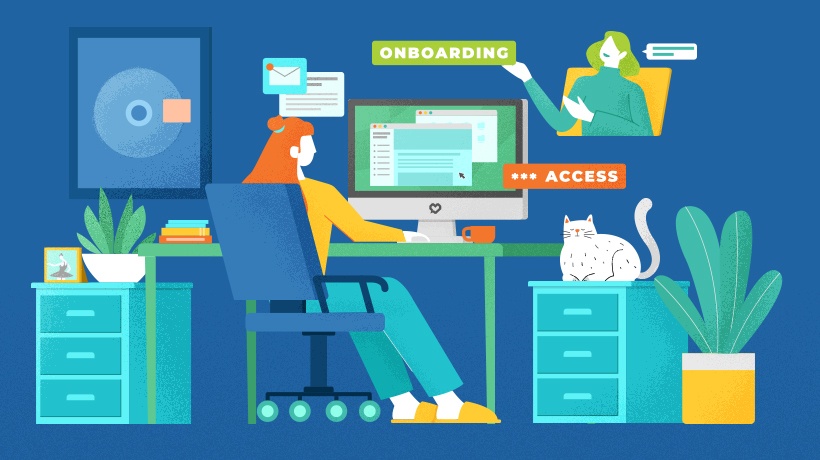Onboarding: A Multi-Layered Process
In an organization with, say, less than fifty or sixty employees, and a single work location, a new employee can typically be on-boarded in a matter of hours. Usually, the hiring manager will introduce the new hire to his/her new supervisor, and the onboarding process commences from there. However, where there are multiple locations, several cross-functional teams, and a hierarchy of management layers, onboarding can take on a life of its own, which can be stressful to the newcomers.
Typically, in mid-sized to larger organizations, onboarding comprises of several steps:
- The Initial Introduction
The newcomer meets with HR, and he/she is introduced to their immediate supervisor/manager. They are processed for access to premises (building, floor, room), and do a lot of preliminary paperwork, including filling out W-4s, I-9s, and State Tax withholding documentation. - Meeting The Team
Next, he/she gets to meet the team that they will be part of. They are shown the layout of their workplace, including facilities and cubicles/offices. Access to and work-related devices (desktops and laptops and cellphones) is usually provided at this stage, and personal cabinet, locker space, and keys are handed to them. - Understanding The Culture
The first two stages of the onboarding are usually informal in nature. The next phase, however, happens in a more formal setting. The new hire is exposed to org-charts, policies and procedures, company aims and objectives, as well as given a deeper understanding of the specific role he/she will play in the company. HR policies are explained, as are company compensation, performance measurement and benefits packages discussed. - Getting Performance-Ready
A further step in the onboarding process involves making the new hire performance-ready, which might require formal training to bridge any gaps that might exist between skills that they have and those required for the job that they will be doing. - Full Integration
Finally, new inductees might enter mentorship relationships with senior team members as part of the onboarding process. This gives them more hands-on exposure to “life on the team”, and it could serve as an invaluable step into full integration into the company.
Depending on the type of organization, the seniority of the job, and the level of complexity of the function being performed, there might be more or fewer layers in the onboarding process. However, what’s certain is that, in order to get the most out of the onboarding process (for both new hires and the organization), there must be a lot of thought put into how new employees are helped to adapt to their new environment.
Making Onboarding Pay Dividends
So, how can an organization make onboarding a win-win process, giving new hires a positive experience, while also ensuring they (new hires) get all that’s needed for them to contribute positively to the company? Here are 4 strategies that can help you do just that:
1. Consider Pre-Onboarding Before Onboarding
One of the largest Accounting, Auditing and Consulting firms in the world, KPMG, implemented a series of pre-onboarding processes that helped change how the company approached the integration of new hires into its workforce. Prior to rethinking its process, onboarding at the firm commenced the first day that new hires showed up to work.
Enter pre-onboarding, and once a contract is signed with a new hire, their integration starts, sometimes months prior to their first day at work. Milestone onboarding tasks then continue well after that first crucial day at work, with scheduled checkpoints taking place 1, 3 and 6 months after the new hires assume their roles at the company.
Not only does that approach result in new employees becoming productive faster because they had a lot of the information they needed to hit the ground running even before they formally joined the company, but it also has a demonstrated increase in new employee retention.
2. Make Onboarding Formal And Not Just Something Peripheral
If your organization believes that onboarding really does pay dividends in the long run, then the best way to act on that belief is to formalize the role that 'onboarders' play in the company. Rather than delegating such a crucial role to a junior assistant in your HR department, make onboarding stand out as a critical business process by making a senior manager responsible for onboarding outcomes. For instance, Facebook has a formal role within its Global People Operations team, titled Onboarding Operations Program Manager, to oversee its onboarding process.
3. Don’t Short-Cut The Onboarding Process
Another strategy to formalize onboarding is by making it a milestone in the career of the new hire, rather than a few days of “learning about the new place”. Instead of providing newly hired engineers a stack of manuals and HR guides, and assigning them quiet-space in the corporate boardroom (i.e. Bored Room!), Facebook, for example, puts its new hires through an intense 2-month long Engineering Boot Camp. Such sessions not only address technical imperatives but also expose new hires to career path progressions and corporate support networks.
4. Leverage Technology Throughout The Onboarding Process
To help make onboarding smoother, organizations should consider using software to add much-needed structure to the process. Onboarding platforms, like Click Boarding, are a great way to help HR managers plan and execute onboarding tasks. All necessary corporate, state and federal forms can be electronically distributed, completed online by new-hires and processed faster than you would do it manually. Using technology provides both onboarding managers as well as new employees, a head start on the onboarding process.
The tech giant, Google, is yet another organization that uses technology (no surprise there!) to keep its massive onboarding process on track. It uses an automated Just-in-Time alert system to keep track of key onboarding milestones, like matching veteran peers to new hires and ensuring monthly check-ins for onboarded new staff. Then, it sends out reminder notifications to managers, so that nothing falls through the crack.
Onboard… Don't Waterboard
Regardless of which of the 4 onboarding strategies discussed above you implement, it may be a good idea to start off by drawing comprehensive checklists that span the entire onboarding process within your organization. Then, consult your frontline HR and line managers to discuss how to implement a process that’s simple and effective.
Sometimes, overzealous onboarding can do as much damage as leaving onboarding to take care of itself. Onboarding managers must, therefore, work to strike a delicate balance between ignoring new hires altogether, and letting them find their own way, or making the onboarding so rigid and torturous for new hires.
In the Instructional Design for eLearning book, you’ll learn everything you need to know about creating truly effective online courses that make the onboarding process easier!
Reference
[1] JazzHR and Click Boarding Bring SMBs Best-in-Breed to Recruit & Onboard New Hires (https://www.prnewswire.com/news-releases/jazzhr-and-click-boarding-bring-smbs-best-in-breed-tools-to-recruit--onboard-new-hires-300445222.html)









